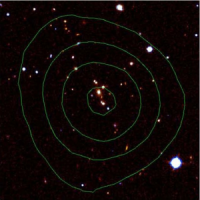Heavyweight Galaxies in the Early Universe Puzzle Astronomers

An international team of astronomers, including two members of the School of Physics and Astronomy, has found massive galaxies in existence when the Universe was barely one third of its current age. These findings, published in Nature on 2 April 2009, cast doubt on current galaxy formation theories, which predict that the stellar mass of large galaxies is built up gradually over time, whereas these observations reveal galaxies as massive as the biggest galaxies found today already in existence some nine billion years ago.
This paper comes from the team undertaking the XMM Cluster Survey (XCS) and was led by Chris Collins and John Stott of Liverpool John Moores University. It continues a decade of research by Collins and Edinburgh astronomer Bob Mann into Brightest Cluster Galaxies (BCGs) - the most massive of all galaxies, found in the cores of galaxy clusters. The XCS is finding galaxy clusters serendipitously in archival data from the European Space Agency's XMM-Newton satellite, using algorithms developed by Edinburgh researcher Michael Davidson for his PhD.
The core of the analysis is a set of near-infrared observations of the BCGs in some of the most distant known galaxy clusters, taken with the Subaru telescope in Hawaii (the image shows the core of one of the clusters, with contours of X-ray emission overlaid), followed by the careful selection of the correct model galaxies from supercomputer simulations with which to compare the properties of the observed BCGs. The comparison is complicated, but the discrepancy between the theoretical predictions and the observational data is so large – theory says that these BCGs should have reached only one fifth of their final mass by the epoch at which they are observed, while the observations imply that they already have 90% of that mass by then – that the authors can robustly conclude that current semi-analytical galaxy formation models fail to capture all the astrophysical processes which affect the formation and evolution of massive cluster galaxies.

